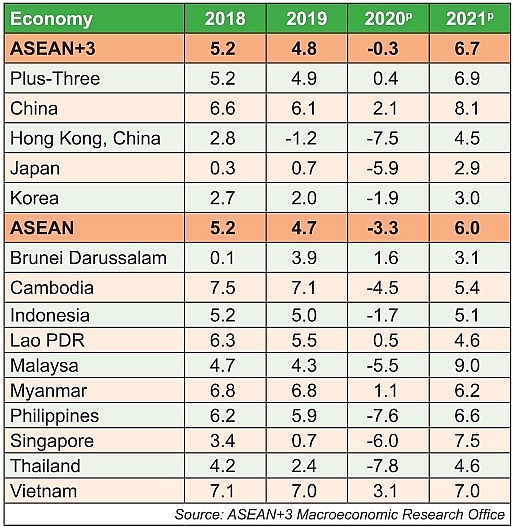Realising revised growth ambitions
Nguyen Minh Cuong, principal country economist from the Asian Development Bank (ADB), told VIR that the bank may soon revise up its recent forecast for Vietnam’s economic growth this year, citing growing domestic consumption, exports, and public investment.
“A few weeks ago, the ADB forecasted that Vietnam’s economy is expected to grow 1.8 per cent in 2020 and then bounce back to 6.3 per cent in 2021. However, I think that the economy may grow higher, especially in the fourth quarter,” Cuong said. “The most important thing for higher economic growth is that the government must continue controlling the COVID-19 pandemic as well as it has so far.”
 |
“When the pandemic is fully under control, it will enable the development of consumption and local demand,” he said. “We are seeing a brighter outlook for the Vietnamese economy, however, and this will continue staying on top of the region this year.”
The economy expanded 2.12 per cent in the first nine months. Though being the lowest rate in 2011-2020, this is considered “the highest in ASEAN where almost all nations suffered from negative growth and in the context that almost all supply chains in the global market have been disrupted,” stated Prime Minister Nguyen Xuan Phuc.
Notably, on-year growth strongly bounced back from 0.39 per cent in the second quarter to 2.62 per cent in the third. PM Phuc has set the new target of 2.5-3 per cent economic growth for the year and asked the Ministry of Planning and Investment (MPI) to devise new growth scenarios until the year’s end.
It is estimated that growth of 1 per cent means nearly 500,000 new jobs created.
According to the MPI, boosting domestic consumption and public investment will be the prime priorities to achieve the new goal.
In the third quarter, the economy’s total retail and consumption service revenue hit over VND1.3 quadrillion ($56.5 billion), up 14.4 per cent compared to the second quarter, and up 4.5 per cent on-year
“Consumers’ confidence has gradually bounced back,” said MPI Minister Nguyen Chi Dung. “Many enterprises have found it difficult to boost exports and then have turned to the domestic market. Many enterprises, already boasting a firm niche at the local market, have been expanding operations here.”
In a specific case, despite the pandemic, TH Group has opened 25 TH true Mart stores so far this year, and will open another 30 in southern localities until the year’s end.
“The new stores will be in southern provinces, not big cities, where demand is strongly growing. Since early this year, milk consumption remains strong, and COVID-19 has failed to prevent consumers from buying our products. That’s why TH Group will continue opening more stores,” said a source from the group, adding that the group has more than 300 stores nationwide.
According to Cuong from the ADB, in addition to spurring on local consumption, the government must accelerate public investment as one of the key pillars for economic growth this year and beyond. Since early this year, many state-funded projects have been put into operation, fuelling socioeconomic development. For example, this week is expected to see the opening of the 5.37km Mai Dich-South Thang Long flyover at Pham Van Dong street in Hanoi after nearly two years of construction, helping eliminate chronic year-long traffic jams.
Costing over VND5.34 trillion ($232.1 million), the project connects the inner city with Thang Long Bridge and Vo Van Kiet road to Noi Bai International Airport, and also connects the city’s big industrial parks and Hanoi with northern provinces.
Not far from the flyover, another one was inaugurated last month with a total investment capital of VND560 billion ($24.3 million), crossing Hoang Quoc Viet and Nguyen Van Huyen streets. The area has been lengthened by a new road that meets with Samsung’s $220 million research and development project.
According to the MPI, total approved development capital from the state budget for 2020 amounts to VND470.6 trillion ($20.4 billion), including VND60 trillion ($2.6 billion) of foreign capital. However, the Ministry of Finance estimated that in the first nine months, 57.2 per cent was disbursed.
Last month, Singapore-based ASEAN+3 Macroeconomic Research Office projected that driven by the nation’s effective anti-virus measures and recovery in domestic consumption and exports, as well as higher public investment, Vietnam may have the highest growth rate in the region this year and the next, at 3.1 and 7 per cent (see box).
In the first nine months, Vietnam’s total export turnover hit $202.86 billion, up 4.2 per cent on-year. The figure was $80.07 billion in the third quarter, up 11 per cent on-year and 34 per cent on-quarter.
What the stars mean:
★ Poor ★ ★ Promising ★★★ Good ★★★★ Very good ★★★★★ Exceptional
Related Contents
Latest News
More News
- PM orders investment model for North–South high-speed rail (December 22, 2025 | 17:43)
- First members of Danang International Finance Centre revealed (December 22, 2025 | 17:39)
- Securing capital and efficiency for Vietnam’s 2026-2030 growth ambitions (December 17, 2025 | 10:00)
- Driving double-digit growth through green and circular transformation in Vietnam (December 17, 2025 | 09:00)
- Vietnam bucking trend in the global M&A landscape (December 16, 2025 | 14:20)
- Vietnam’s green transition demands collective financial action (December 15, 2025 | 12:00)
- VIR workshop highlights capital and policy for sustainable development (December 15, 2025 | 11:00)
- National Assembly approves pilot mechanisms to accelerate major projects in Hanoi (December 12, 2025 | 11:29)
- Vietnam eases policy approval requirements, simplifies foreign and outbound investments (December 11, 2025 | 17:53)
- Unpacking new momentum in Vietnam’s M&A market (December 10, 2025 | 09:59)

 Tag:
Tag:




















 Mobile Version
Mobile Version